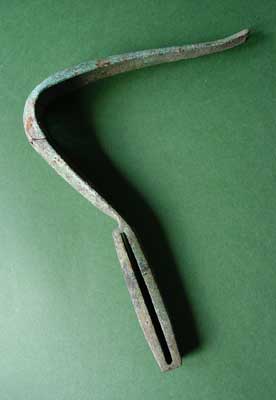 |
| Panonien (Hungary) Bronze, 2.-4. century. BC. |
The most intimate connection between baths and ointments is always apparent from the writings of the ancient physicians. They affect the healthy as well as the sick. The oils and ointments not only make the skin supple and give it substance. Rather, the body also absorbs the flavors and other things through the skin. It seems ancient times knew about it. ..
The Romans did not like hairy as the monkeys get into the bathroom. They therefore shaved from head to toe. They then washed the body with potash (potassium carbonate, K2CO3), called borite, which had a cleansing effect similar to that of our soaps.
The solid soap was first known to the Romans in contact with the Gauls, who used it as a hair care and coloring agent. The Romans initially used these soaps only as cosmetics. Only from the 2nd century AD. they used soap for cleansing - the firmer Germanic soap was particularly popular, to which they added fragrances from the Mediterranean ... (GALENUS is the first to testify that the Romans used soap for washing). Pumice, clayey earth and bath oils completed the arsenal of care products ...
The excess potash of the "soap" attacked the skin (discolored hair, among other things!). So it was only logical if the Romans oiled themselves after the ablution and massaged themselves in this state. Athletes additionally used sand to clean the body, which combined with the oil to form a puffy layer. This one grazed one (or let itself of a servant remove) with a "strigilis" resp. "Strigilles" (French le racloir, German the scraper) from arm and leg off. Oiling and scraping could take place in the same room, but also in two separate rooms
- the "unctorium" for oiling,
- the "destrictarium", to scrap the oil. In the Greek palaces, the space was usually arranged around the peristyle courtyard.
In both rooms, the bather could resort to the help of medically trained staff:
- the "aliptes", the masseur,
- the "iatraliptes", a bath doctor who had real medical knowledge.
The Romans rubbed in olive oil and then removed excess oil with a scraper. This oil-soluble dirt was removed while maintaining the skin. Whether the bather should oil before or after bathing, or both before and after the bath, the doctors argued (CELSUS, GALENUS).
Bathers carried a ring with two or three strigels and an oil container attached to it - a beautiful specimen in the Museum of Naples. They were used - occupied by historical sources (Kotera-Feyer 1993, 3 ff.) - Initially, only by athletes in the Palästra and were therefore initially found only in graves of male individuals. Relatively soon, however, Strigiles were also used by women for body cleansing and care, as can be seen on vase paintings. However, the strigiles always played only a minor role in the life and burial of women (Prohászka 1998, 801).
Presented is a single (unfortunately broken) 22x17 cm Strigilis with hollow handle from the 2nd-4th Century AD, which originates from the old part of Buda (pest) in Hungary - at the time of the Romans called the city Aquincum - the city of the water: from a more evocative place the Badeutensil could hardly originate ...
On one of the Danube islands near Aquincum, the so-called "shipyard island" of Obuda, one found extensive wall remnants of a governor's villa. This possessed a large, luxurious private bath.
(Le Caducee, 26 rd du Chevreuil, Brussels).
Lit. :
- M. Weber, Antike Badekultur, C.H. Beck Verlag, München 1996.
- Kotera-Feyer, Ellen: Die Strigilis. Frankfurt/M., Berlin, Bern, New York, Paris, Wien, 1993. XV, 241 Seiten mit zahlreichen Abbildungen. Europäische Hochschulschriften, Reihe 38: Archäologie Band 43.
- E. Künzl, Strigilis. In: Der Neue Pauly. Enzyklopädie der Antike 11 (Stuttgart/Weimar 2001) Sp. 1055.
|




